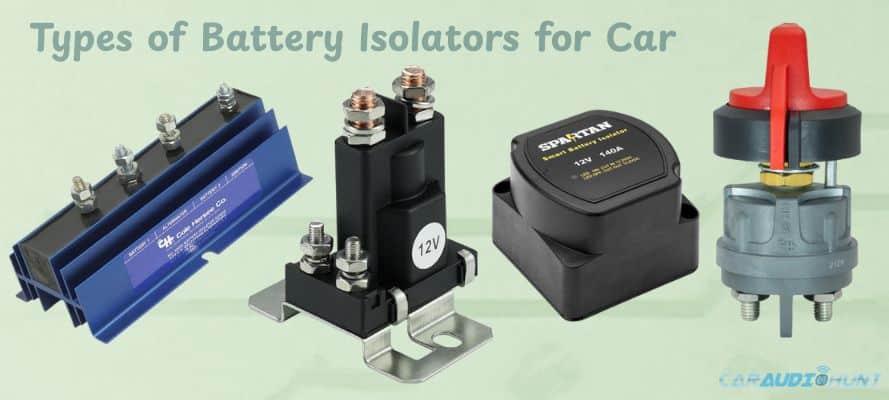When you’re powering amps, fridges, winches, or running a dual battery setup, your electrical system is only as reliable as the barrier protecting your starter battery. And that barrier is your battery isolator.
A good battery isolator doesn’t just separate batteries. It separates peace of mind from a dead start. Over the years, I’ve tested and installed different types of battery isolators for car audio that are exactly what you’ll see in this guide. Here, I’ll break down exactly how each isolator works, where it shines, and how to choose the right one for your ride and lifestyle. Let's explore.
In This Article
- Exploring 4 Different Types of Battery Isolators for Car
- Comparison Table: Which Battery Isolator Is Best for Your Car?
- Frequently Asked Questions
- What does a battery isolator do in a car or car audio system?
- Do I really need a battery isolator for my setup?
- How does a 12V battery isolator work?
- Is a battery isolator just a relay, or how is it different?
- Do battery isolators cause voltage drop?
- Can I use a battery isolator without a second alternator?
- Can I use a battery isolator with lithium batteries?
- Do battery isolators work with smart alternators?
- Is a smart isolator worth it compared to a manual relay?
- What’s the best type of battery isolator for a daily driver?
- Conclusion
Exploring 4 Different Types of Battery Isolators for Car
1. Diode-Based Battery Isolators
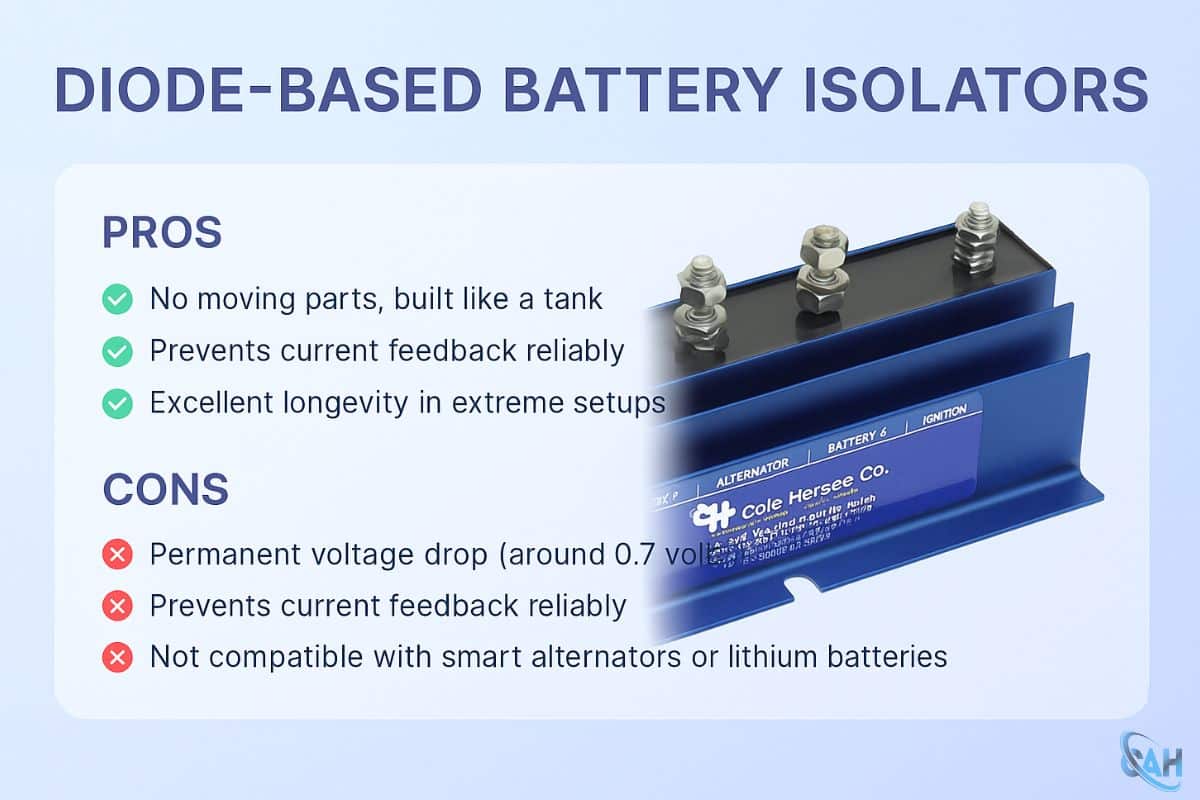
Diode isolators act as one-way gates for current. They allow power to flow in one direction while blocking reverse flow. Using high-current semiconductors, they direct power from the alternator to multiple batteries and prevent backfeed between them.
They are simple, reliable, and require little maintenance. However, they cause a small voltage drop, which can slightly reduce charging efficiency.
Pros
Cons
Best Use Cases: Vintage cars and classic restorations, Marine or rugged environments, and Basic systems with minimal voltage sensitivity.
2. Relay-Based Battery Isolators (Solenoids)
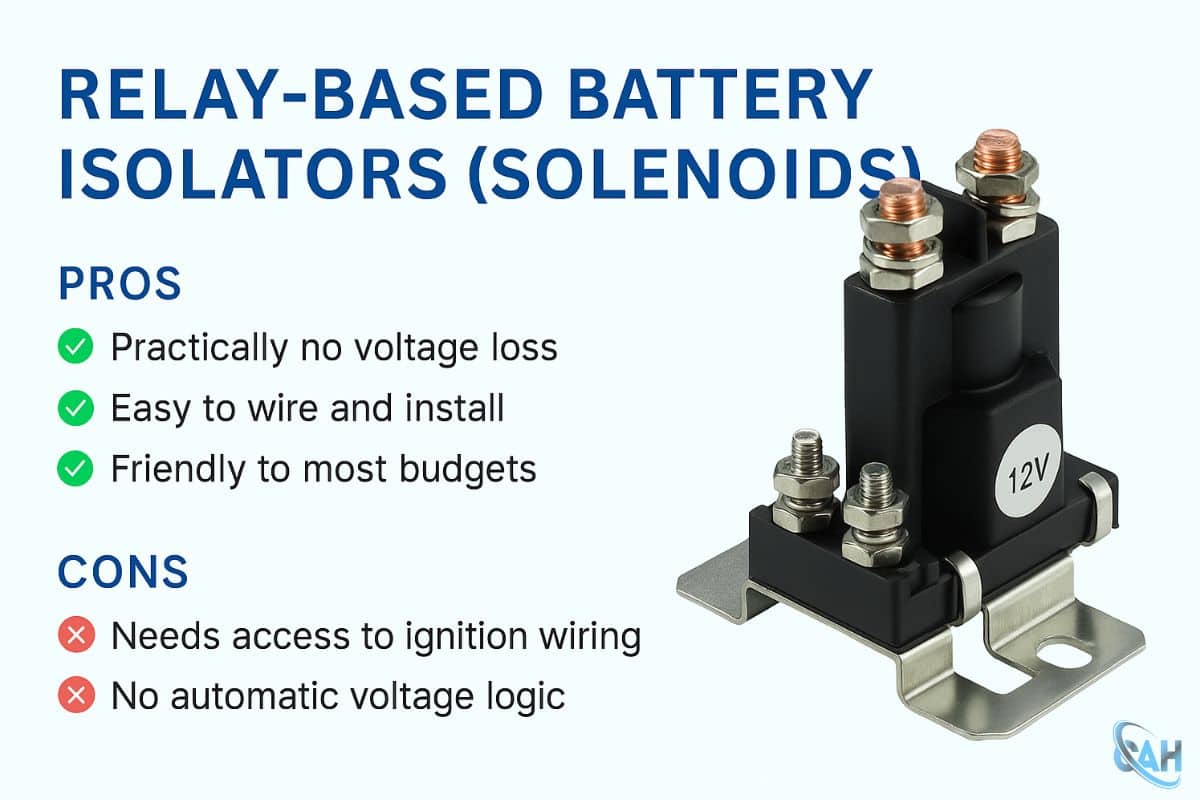
Relays act like traffic cops. They open or close the circuit based on your ignition status. When your engine is on, the solenoid connects both batteries. Turn it off, and they’re isolated.
For anyone building their first dual battery system, this is a smart start. I often recommend it to budget builders or DIYers who want simplicity. Just remember, relays don’t think. They switch on or off based purely on ignition, which sometimes misses charging chances or disconnects early.
Pros
Cons
Best Use Cases: Entry-level car audio builds, Basic dual battery weekend rigs, and Users who prefer switch-based control.
3. Smart Battery Isolators (Voltage-Sensing Relays)
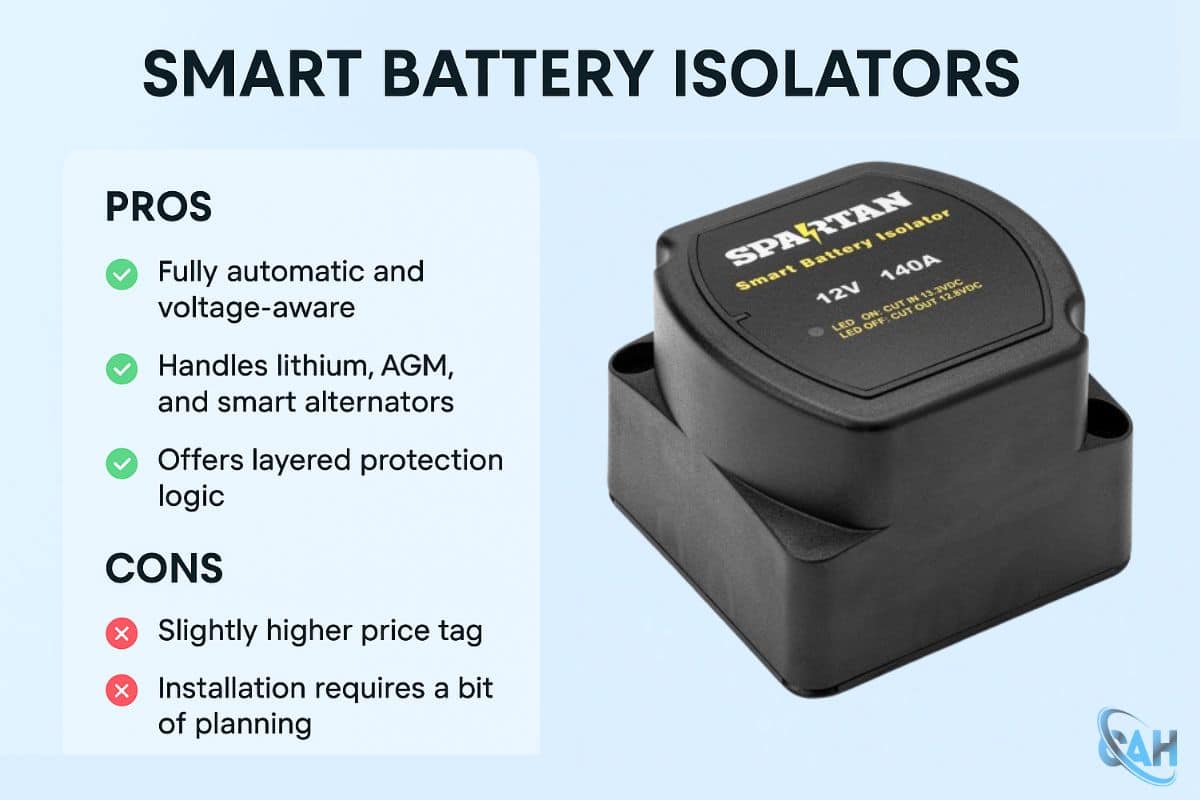
Now we’re in the automation zone. Smart isolators constantly monitor voltage. When your starter battery hits a charge threshold (usually around 13.3 volts), it connects the auxiliary battery. Drop below that, and it disconnects to protect your cranking battery.
If your setup has a smart alternator, solar panel, or lithium batteries, this is what I recommend. No ignition tapping needed, and it just works intelligently.
Pros
Cons
Best Use Cases: Overlanders with solar and lithium, High-power car audio enthusiasts, and Daily drivers with advanced alternators.
4. Manual Battery Switches
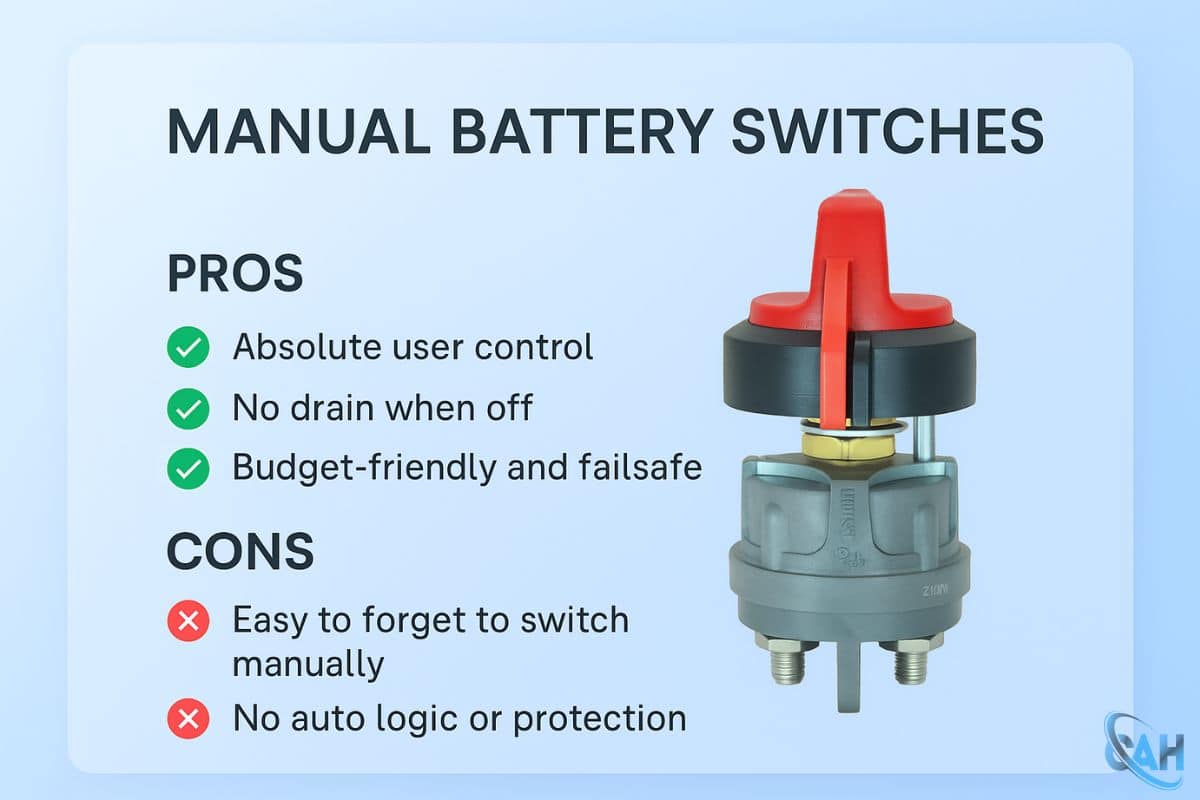
These are the no-nonsense mechanical levers. You turn them on or off manually to connect or disconnect your batteries. No sensors, no triggers. Just old-school user control.
I always suggest adding a manual switch as a backup layer. They are very helpful in diagnostics or field failure scenarios. It’s analog but dependable when you need it most.
Pros
Cons
Best Use Cases: Seasonal vehicles or fleets, RVs, boats, or emergency override setups
and Builders who want manual control and redundancy.
Comparison Table: Which Battery Isolator Is Best for Your Car?
Unsure which isolator suits your setup? The table below compares the main types to help you choose based on system complexity, performance, and cost.
Type | Voltage Drop | Automation | Complexity | Best For | Cost |
|---|---|---|---|---|---|
Diode Isolator | High (~0.7V) | No | Low | Basic setups, protection-first | affordable |
Relay/Solenoid | Minimal | No | Medium | Budget builds, car audio | Cheaper |
Smart Isolator (VSR) | Minimal | Yes | Medium | Overlanding, mixed batteries, audio | Higher |
Manual Switch | None | No | Very Low | Emergency, fleet, seasonal use | cheaper |
Frequently Asked Questions
Here are some of the most common questions I get from car audio builders when it comes to the different types of battery isolators.
What does a battery isolator do in a car or car audio system?
A battery isolator allows your alternator to charge both your main and auxiliary batteries while keeping them electrically separated when the engine is off. This prevents your starter battery from being drained by accessories and ensures that your car can always start, no matter how much power you're using elsewhere.
Do I really need a battery isolator for my setup?
Yes, if you're running a dual battery setup or powering high-demand accessories like amplifiers, fridges, or winches. Without an isolator, your starter battery could easily get drained, leaving you stranded.
How does a 12V battery isolator work?
A 12V battery isolator manages current flow between your starter and auxiliary batteries. It either uses voltage sensing or ignition triggers to decide when to connect or disconnect the batteries, ensuring both are charged when needed and isolated when they shouldn’t be sharing power.
Is a battery isolator just a relay, or how is it different?
Some isolators are basic relays, but advanced models like smart isolators have built-in logic. They can detect voltage levels and act automatically, whereas a simple relay requires manual or ignition-based activation.
Do battery isolators cause voltage drop?
Only diode-based isolators cause a noticeable voltage drop, typically around 0.7 volts. Relay and smart isolators are more efficient and have minimal to no voltage loss.
Can I use a battery isolator without a second alternator?
Absolutely. Most vehicles use a single alternator, and all the isolators discussed in this guide are designed to work with that configuration. You only need to make sure the isolator can handle your system's current.
Can I use a battery isolator with lithium batteries?
Yes, but you should avoid diode or simple relay isolators unless they're specifically designed for lithium chemistry. Smart isolators with voltage control and lithium compatibility are best for these setups.
Do battery isolators work with smart alternators?
Only smart isolators are built to handle the voltage variability of modern smart alternators. Basic relays can misfire or fail in these conditions, leading to incomplete charging or system faults.
Is a smart isolator worth it compared to a manual relay?
For modern builds or daily drivers, yes. The automatic control, voltage protection, and convenience of a smart isolator far outweigh the manual input required by a relay. It simplifies your setup and adds a layer of reliability.
What’s the best type of battery isolator for a daily driver?
Go for a smart isolator. It automates battery protection without any manual switches or wiring to the ignition. It’s reliable, efficient, and ideal for vehicles used regularly.
Conclusion
Choosing the right types of battery isolators for car comes down to knowing your power needs, vehicle type, and how much automation you want. In my experience:
- Smart isolators are the best all-around, if you have modern builds with mixed batteries or high-draw accessories.
- Relay-based systems are excellent for beginners or budget-conscious builders.
- Diode isolators perform best in rugged, no-frills environments where simplicity and reliability matter most.
- Manual switches are perfect as a backup control layer or for users who prefer full hands-on management.
After picking the right type of isolator, make sure your system is fused properly, wires are correctly sized, and everything is tested under load. A battery isolator is not only a component but also the gatekeeper of your electrical system’s safety and reliability.
Explore Related Guides:
